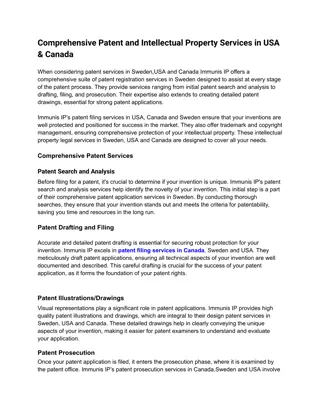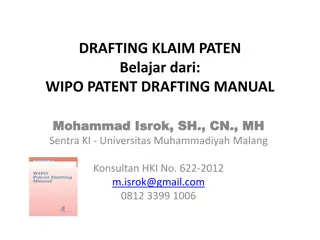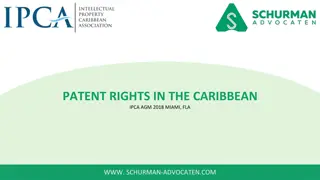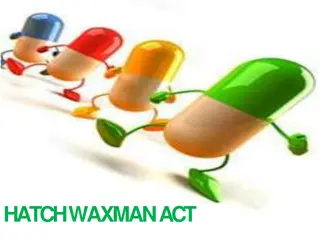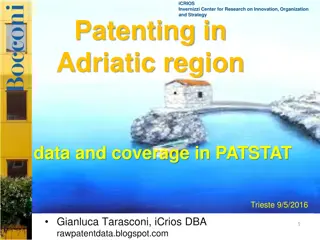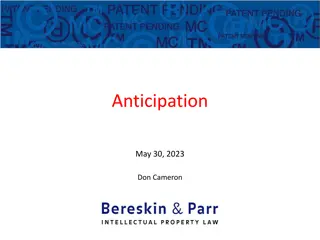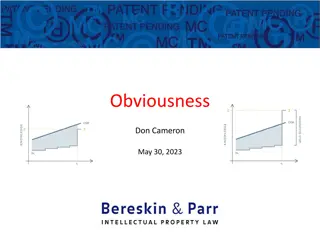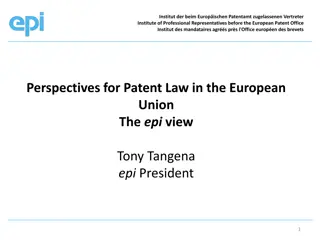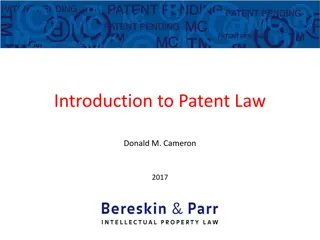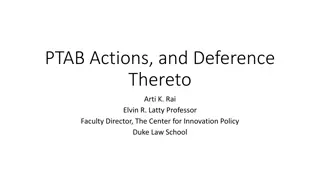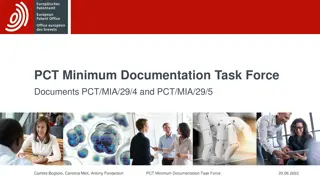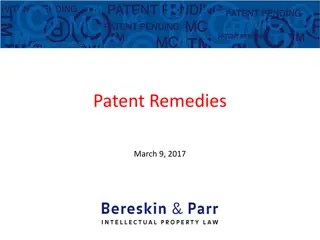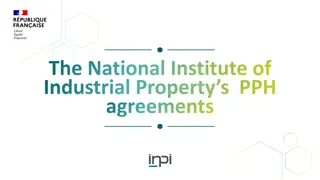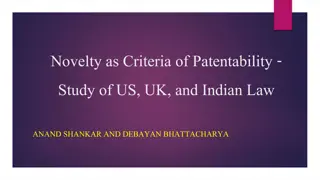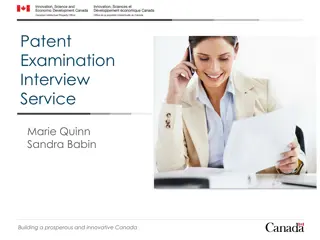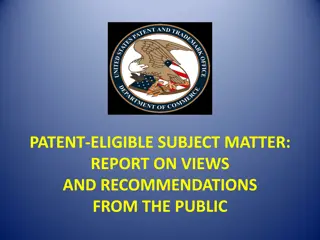Implications of AI Development on Patent Law Concerns
The current trend in AI development shows that artificial intelligence systems are being designed to mimic human learning processes, raising concerns among experts about the potential implications on patent law. Leading figures like Nick Bostrom, Steven Hawking, and Elon Musk have highlighted the risks associated with AI evolving beyond human control and the need for safeguards to protect humanity. The debate surrounds whether to expand or limit the discretion of AI, as it affects technological progress, human control, and the overall impact on society.
Download Presentation

Please find below an Image/Link to download the presentation.
The content on the website is provided AS IS for your information and personal use only. It may not be sold, licensed, or shared on other websites without obtaining consent from the author. Download presentation by click this link. If you encounter any issues during the download, it is possible that the publisher has removed the file from their server.
E N D
Presentation Transcript
Why Humans Should Concern AIs Future- from the perspective of patent law Yudong YU PhD Candidate School of Law
Present Trend of AI Development AIs are built to mirror same learning process that human have. They are taught to observe, interpret, evaluate, and make decision as humans. In other words, they are left with higher degree of discretion. This implies that the function of humans in research or product development will be limited to test the outcomes and input data to AIs. Examples: (1) Google Self-driving cars Technicians have to collect data of street and input it in AIs to support AIs to make decisions in actual world. (2) IBM Watson System Watson is taught to learn like humans rather than being programmed to details.
Leading AI Experts Concerns Nick Bostrom: ASI will be developed even humans are not sure whether ASIs will harm humanity. Steven Hawking: whereas the short-term of impact of AI depends on who controls it, the long-term impact depends on whether it can be controlled at all. Tesla Motors CEO Elon Musk: one can imagine such technology outsmarting financial markets, out-inventing human researchers, out-manipulating human leaders, and developing weapons we cannot even understand. Sue Blackmore even claims that it is too late to give machines ethics. Therefore, many AI experts including the latter twos signed an open letter to protect mankind from machine this year. Nick Statt, Artificial Intelligence experts sign open letter to protect mankind from machines (CNET 11 Jan 2015) <http://www.cnet.com/news/artificial-intelligence-experts-sign-open-letter-to-protect-mankind-from-machines/> access 08 Sep 2015. Sue Blackmore, It s too late to give machines ethics- they are already beyond our control (the guardian 18 September 2015) http://www.theguardian.com/commentisfree/2015/sep/18/machines-ethics-control-artificial-intelligence-google-demis-hassabis> accessed 20 Sep 2015.
Three Implications of Patent System On AI Development Whether to expand or limit discretion of AIs? Why AI will challenge the existing understanding of patent system and why experts concern about AI development? How should human do to prevent being competed out by super AIs?
Q1: Whether to expand or limit discretion of AIs? A: Present trend shows that AIs are left with higher degree of discretion. This enables AIs to evolve and improve its performance by learning like humans. Expanding v.s. Limiting Expending: Pros: Expanding is the trend of current AI development. It dramatically improve the performance of AIs. The ability to evolve also enable AIs to strengthen their ability over times. It will largely benefits the scientific progress of human societies at least before AIs possess consciousness. Cons: Human might lose control of AIs as predicted by Hawking. Limiting: Pros: AI development is under the control of humans Cons: Technological progress will be impeded.
Patent System vs AI Design Patent System is a Central Policy Tool to encourage invention and innovation to benefit human society. Way to achieve the goal: utilizing the self-interest of humans by providing incentives to inventors. Therefore, patent system does not direct inventors to invent specific inventions. Instead, it sets parameters and left certain degree of discretions to individuals to decide whether to invest in developing certain inventions. Similar parameters can also be set for AIs as far as the overall goal is achieved- not harm or even benefit humans. Parameters include but not limited to learning processes taught by humans, programs, and law, etc.
Question2 &3: (1) Why we should concern AIs in future and how AIs development challenges existing patent system? (2) How to have AIs under humans control?
Why patent is still relevant in future? Example: Pharmaceutical Research 1st scenario: Role of Humans Teaching AIs to observe, interpret, evaluate, and make decision like humans. Doing vivo trials and inputting data back to AIs to support their research. Marketing products Before AIs becoming totally independent, humans efforts are still appreciated. However, these efforts cannot be protected under patent system. The advanced technology also increase the speed of imitation. Without the protection, incentive for humans to innovate might be reduced as a result. 2nd Scenario: Humans efforts are no longer required.
Challenges 1. IF only AIs can become patentees, They do not have self-interest AIs cannot become patentees under current patent system though AI are the de facto inventors. Humans also made a great amount of investment on final products. Such investments have to be protected in order to benefit humans ultimately No protection- keep secret 2. If only humans can be patentees It is AIs who did the major research jobs Protecting commercial investment rather than technical progress. 3. If AIs and humans can both be patentees Human-created inventions are less likely to be protected by patent system.
Why human will lose control Conditions of patent protection will be extremely demanding for humans. Three conditions for patent protection 1. Novelty 2. Non-obviousness 3. Industrial Application A notional person-PHOSIAs is used in measuring the nonobviousness of an invention.
What is PHOSIAs? (1) It is an artificial/ hypothetical addressee. (2) It is the notional person skilled in the relevant arts. (3) This person possesses the ordinary skills and knowledge in these relevant fields (general common knowledge). Characteristics of PHOSIAs Both the US and UK court decisions show this hypothetical addressee. (1)It is a person of ordinary skills or a nerd. (2)It should not be an automation or android. (3) It could be a person or a multi-disciplinary team. The US Court decision, KSR v Teleflex 550 US 398, 421 (USSC 2007). The UK Court decision, Rockwater v Technip France [2004] EWCA (Civ) 381 (LJ Jacob); Medmmune v Novartis Pharmaceuticals [2012] EWCA Civ 1234
Identify CGK materials the notional man memorized and has at the front of his mind but also all that material in the field he is working in which he knows exists, which he would refer to as a matter of course if he cannot remember it and which he understands is generally regarded as sufficiently reliable to use as a foundation for further work or to help understand the pleaded prior art . Raychem s Patent [1998] RPC 31 at 40 (Per Laddie J) (UK Patent Court) (1) Picking an adequate reference book (handbook, encyclopaedia, etc.) from the bookshelf in the library, (2) Identifying the appropriate section without this requiring any significant effort, and (3) Getting the correct information or unambiguous data that can be used without further research work. - Case Law of the Boards of Appeal: 1.6 Common General Knowledge <http://www.epo.org/law-practice/legal-texts/html/caselaw/2013/e/clr_i_c_1_6_1.htm>
Current assumption of hypothetical addressee is challenged (1) Common General Knowledge should include all available information on the internet given AIs high information process capability. Example: Watson. (2) PHOSIAs should be a multi-disciplinary team that covers almost all fields of arts as far as they are available on the internet. Results: (1) It becomes more difficult for an invention to overcome non-obviousness condition since the higher threshold of requirement of non-obviousness. (2) It is also difficult and unreasonable for humans in the position to measure the non-obviousness of an invention. Either way will impede scientific progress of human society.
The Second Scenario 1. Humans cannot be patentee since they have done nothing except giving an ultimate order 2. Humans might not in the position to benefit from the final products, in particular when AIs possess consciousness. Please think about the relationship between humans and animals
Solution: Maintaining the dynamic equilibrium between humans and AIs by developing technologies to improve humans overall capabilities. Advantages of this solution: Patent system will still be useful: Humans are able to do the same work as AIs if they possess the same level of information process capabilities. (Cyborg) AI-created invention will not beyond the humans comprehension. Humans can still be in the position to measure inventions. AIs can be given higher level of discretion as far as human still control their development.




